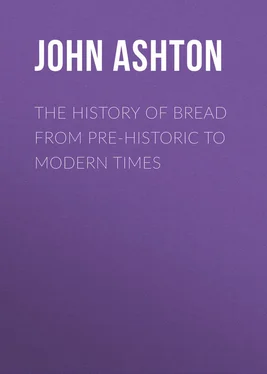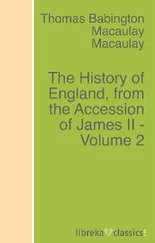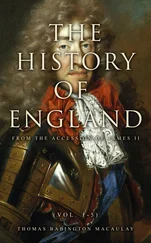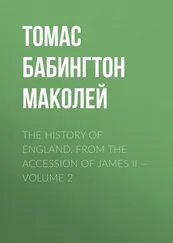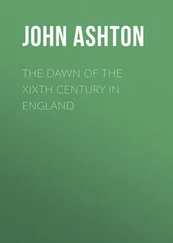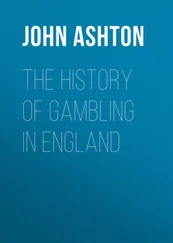John Ashton - The History of Bread From Pre-historic to Modern Times
Здесь есть возможность читать онлайн «John Ashton - The History of Bread From Pre-historic to Modern Times» — ознакомительный отрывок электронной книги совершенно бесплатно, а после прочтения отрывка купить полную версию. В некоторых случаях можно слушать аудио, скачать через торрент в формате fb2 и присутствует краткое содержание. Жанр: foreign_antique, foreign_prose, на английском языке. Описание произведения, (предисловие) а так же отзывы посетителей доступны на портале библиотеки ЛибКат.
- Название:The History of Bread From Pre-historic to Modern Times
- Автор:
- Жанр:
- Год:неизвестен
- ISBN:нет данных
- Рейтинг книги:3 / 5. Голосов: 1
-
Избранное:Добавить в избранное
- Отзывы:
-
Ваша оценка:
- 60
- 1
- 2
- 3
- 4
- 5
The History of Bread From Pre-historic to Modern Times: краткое содержание, описание и аннотация
Предлагаем к чтению аннотацию, описание, краткое содержание или предисловие (зависит от того, что написал сам автор книги «The History of Bread From Pre-historic to Modern Times»). Если вы не нашли необходимую информацию о книге — напишите в комментариях, мы постараемся отыскать её.
The History of Bread From Pre-historic to Modern Times — читать онлайн ознакомительный отрывок
Ниже представлен текст книги, разбитый по страницам. Система сохранения места последней прочитанной страницы, позволяет с удобством читать онлайн бесплатно книгу «The History of Bread From Pre-historic to Modern Times», без необходимости каждый раз заново искать на чём Вы остановились. Поставьте закладку, и сможете в любой момент перейти на страницу, на которой закончили чтение.
Интервал:
Закладка:
Dr. Schliemann claimed to have found the site of ancient Troy when he uncovered the hill of Hissarlik. It was undoubtedly the remains of a pre-historic city, and one which had advanced to a considerable amount of civilisation. And this is shown particularly in one instance, in the huge earthenware jars, or pithoi , that were used for storing corn and wine. The following illustration gives a graphic description of them as they appeared in situ : ‘One of the compartments of the uppermost houses below the Temple of Athené, and belonging to the third, the burnt city, appears to have been used as a magazine for storing corn or wine, for there are in it nine enormous earthenware jars of various forms, about 5 ft. high and 4-3/4 ft. across, their mouths being from 29-1/2 in. to 35-1/4 in. broad. Each of them has four handles 3-3/4 in. broad, and the clay of which they are made is as much as 2-1/4 in. thick.’ 7 7 Ilios. By Dr. H. Schliemann. London, 1880, pp. 32, 33.
Dr. Schliemann says [p. 279]: ‘The number of large jars which I brought to light in the burnt stratum of the third city certainly exceeds 600. By far the larger number of them were empty, the mouth being covered by a large flag of schist or limestone. This leads me to the conclusion that the jars were filled with wine or water at the time of the catastrophe, for there appears to have been hardly any reason for covering them if they had been empty. Had they been used to contain anything else but liquids, I should have found traces of the fact, but only in a very few cases did I find some carbonised grain in the jars, and only twice a small quantity of a white mass, the nature of which I could not determine.’
So that we see that this pre-historic nation not only grew corn, but stored it for future use.
The means this pre-historic people had of crushing or mealing the grain was the same as usual: the saddle querns, or two stones with flat surfaces, between which the grain was crushed and roughly triturated – so frequently found on the Continent, and the pestle and mortar of the lake dwellings, as also round stones for fitting into hollows such as are found in the lakes, the cave dwellings of the Dordogne and in the dolmens of France. Dr. Schliemann, in describing ‘the Trojan saddle querns,’ says they ‘are either of trachyte or of basaltic lava, but by far the larger number are of the former material. They are of oval form, flat on one side and convex on the other, and resemble an egg cut longitudinally through the middle. Their length is from 7 in. to 14 in., and even as much as 25 in.; the very long ones are generally crooked longitudinally, their breadth is from 5 in. to 14 in. The grain was bruised between the flat sides of two of these querns; but only a kind of groats can have been produced in this way, not flour. The bruised grain could not have been used for making bread. In Homer we find it used for porridge ( Il. xviii., 558-560), and also for strewing on the roasted meat ( Od. xiv., 76-77).’
In Homeric times the corn was evidently ground by millstones (which were, probably, precisely similar to those found by Dr. Schliemann), as we see in Il. vii. 270, xii., 161, and Od. vii., 104, xx., 105. Pliny N.H., xxxvi., 30, speaking of millstones says: ‘In no country are the molar stones superior to those of Italy; stones, be it remembered, not fragments of rock; there are some provinces, too, where they are not to be found at all. Some stones of this class are softer than others, and admit of being smoothed with the whetstone, so as to present all the appearance, at a distance, of serpentine. There is no more durable stone than this; for, in general, stone, like wood, suffers from the action, more or less, of rain, heat, and cold… Some persons give this molar stone the name of pyrites , from the circumstance that it has a great affinity to fire.’
In book xviii., 23, Pliny gives us the mode of grinding corn . ‘All the grains are not easily broken. In Etruria they first parch the spelt in the ear, and then pound it with a pestle shod with iron at the end. In this instrument the iron is notched at the bottom, sharp ridges running out like the edge of a knife, and concentrating in the form of a star, so that, if care is not taken to hold the pestle perpendicularly while pounding, the grains will only be splintered and the iron teeth broken. Throughout the greater part of Italy, however, they employ a pestle that is only rough at the end, and wheels turned by water, by means of which the corn is gradually ground. I shall here set forth the opinions given by Mago as to the best method of pounding corn. He says that the wheat should be steeped first of all in water, and then cleaned from the husk, after which it should be dried in the sun and then pounded with the pestle; the same plan, he says, should be adopted in the preparation of barley.’
This was how corn was prepared in some parts of Italy at the time of the Christian era, by the same method as that described by Livingstone: ‘The corn is pounded in a large wooden mortar, like the ancient Egyptian one, with a pestle six feet long and about four inches thick. The pounding is performed by two or even three women at one mortar. Each, before delivering a blow with her pestle, gives an upward jerk of the body, so as to put strength into the stroke, and they keep exact time, so that two pestles are never in the mortar at the same moment… By the operation of pounding, with the aid of a little water, the hard outside scale or husk of the grain is removed, and the corn is made fit for the millstone. The meal irritates the stomach unless cleared from the husk; without considerable energy in the operation the husk sticks fast to the corn. Solomon thought that still more vigour than is required to separate the hard husk or bran from the wheat would fail to separate “a fool from his folly.” “Though thou shouldest bray a fool in a mortar among wheat with a pestle, yet will not his foolishness depart from him.”’
We have noticed the primitive Homeric millstones and the Etruscan pestles and mortars, but at the time of the Christian era things molinary were somewhat more advanced. Doubtless in parts of the country the hand mill or quern, called Mola manuaria , versatilis or trusatilis , was in use, and it was worked by slaves, who were sent to the pistorineum as a punishment. But the usual corn mill was worked by animals, and was called Mola iumentaria or Mola asinaria .
Both Greeks and Romans originally ground their flour and baked their bread at home, and mills and bakeries have been found in several private houses in Pompeii. One of these bakeries was attached to the house of Sallust, on the south side, being divided from it only by a narrow street. Its front is the main street, or Via Consularis, leading from the gate of Herculaneum to the Forum. Entering by a small vestibule, the visitor finds himself in a portico of ample dimensions, considering the character of the house, being about 36 feet by 30 feet. At the end of the portico is an opening through which the bake-house is entered, which is at the back of the house, and opens into a smaller street, which, diverging from the main street at the fountain by Pansa’s house, runs straight up to the city walls. The work room of the mill and bakery is about 33 feet long by 26 feet. The centre is occupied by four stone mills, and when it was uncovered, the ironwork, though entirely rust eaten, was yet perfect enough to explain satisfactorily the method of construction.
Not only were the flour mills, kneading troughs and other utensils for baking found in Pompeii, but there were also loaves of bread, of round form, and sub-divided, some of which were stamped with the baker’s name. That this was the usual form of loaf is also shown by a painting on the walls of the Temple of Augustus, where we see the bread partially broken, and by the representation of a baker’s shop, where all the loaves are similarly shaped.
Читать дальшеИнтервал:
Закладка:
Похожие книги на «The History of Bread From Pre-historic to Modern Times»
Представляем Вашему вниманию похожие книги на «The History of Bread From Pre-historic to Modern Times» списком для выбора. Мы отобрали схожую по названию и смыслу литературу в надежде предоставить читателям больше вариантов отыскать новые, интересные, ещё непрочитанные произведения.
Обсуждение, отзывы о книге «The History of Bread From Pre-historic to Modern Times» и просто собственные мнения читателей. Оставьте ваши комментарии, напишите, что Вы думаете о произведении, его смысле или главных героях. Укажите что конкретно понравилось, а что нет, и почему Вы так считаете.
